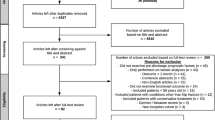Abstract
Background
Hip fracture in older patients often lead to permanent disabilities and can result in mortality.
Objective
To identify distinct disability trajectories from admission to one-year post-discharge in acutely hospitalized older patients after hip fracture.
Design
Prospective cohort study, with assessments at admission, three-months and one-year post-discharge.
Setting and participants
Patients ≥ 65 years admitted to a 1024-bed tertiary teaching hospital in the Netherlands.
Methods
Disability was the primary outcome and measured with the modified Katz ADL-index score. A secondary outcome was mortality. Latent class growth analysis was performed to detect distinct disability trajectories from admission and Cox regression was used to analyze the effect of the deceased patients to one-year after discharge.
Results
The mean (SD) age of the 267 patients was 84.0 (6.9) years. We identified 3 disability trajectories based on the Katz ADL-index score from admission to one-year post-discharge: ‘mild’- (n=54 (20.2%)), ‘moderate’- (n=110 (41.2%)) and ‘severe’ disability (n=103 (38.6%)). Patients in all three trajectories showed an increase of disabilities at three months, in relation to baseline and 80% did not return to baseline one-year post-discharge. Seventy-three patients (27.3%) deceased within one-year post-discharge, particularly in the ‘moderate’- (n=22 (8.2%)) and ‘severe’ disability trajectory (n=47 (17.6%)).
Conclusions
Three disability trajectories were identified from hospital admission until one-year follow-up in acutely hospitalized older patients after hip fracture. Most patients had substantial functional decline and 27% of the patient’s deceased one-year post-discharge, mainly patients in the ‘moderate’- ‘and severe’ disability trajectories.




Similar content being viewed by others
References
Dubljanin-Raspopovic E, Markovic-Denic L, Matanovic D, Grajic M, Krstic N, Bumbasirevic M. Is pre-fracture functional status better than cognitive level in predicting short-term outcome of elderly hip fracture patients? Arch Med Sci 2012; 29: 115–22.
Eastwood EA, Magaziner J, Wang J, Silberzweig SB, Hannan EL, Strauss E, et al. Patients with hip fracture: subgroups and their outcomes. J Am Geriatr Soc 2002; 50: 1240–49.
Tseng M, Shyu YL, Liang J. Functional recovery of older hip-fracture patients after interdisciplinary intervention follows three distinct trajectories. Gerontol 2012; 52: 833–42.
Chudyk AM, Jutai JW, Petrella RJ, Speechley M. Systematic review of hip fracture rehabilitation practices in the elderly. Arch Phys Med Rehabil 2009; 90: 246–62.
Vergara I, Vrotsou K, Orive M, Gonzalez N, Garcia S, Quintana JM. Factors related to functional prognosis in elderly patients after accidental hip fractures: a prospective cohort study. BMC Geriatr 2014; 14: 124.
Mathew RO, Hsu WH, Young Y. Effect of comorbidity on functional recovery after hip fracture in the elderly. Am J Phys Med Rehabil 2013; 92: 686–96.
McCusker J, Kakuma R, Abrahamowicz M. Predictors of functional decline in hospitalized elderly patients: a systematic review. J Gerontol A Biol Sci Med Sci 2002; 57: M569–77.
Neuman MD, Siber JH, Magaziner JS, Passarella MA, Mehta S, Werner RM. Survival and functional outcomes after hip fracture among nursing home residents. JAMA internal medicine 2014; 174: 1273–80.
Magaziner J, Hawkes W, Hebel JR, Zimmerman SI, Fox KM, Dolan M, et al. Recovery from hip fracture in eight areas of function. J Gerontol A Biol Sci Med Sci 2000; 55: 498–507.
Gill T, Murphy T, Gahbauer E, Allore H. The course of disability before and after a serious fall injury. JAMA internal medicine 2013; 173: 1780–86.
Aronow HU, Sharkey P, Siebens HC, Horn SD, Smout RJ, De Jong G, et al. Initial recovery trajectories among patients with hip fracture: a conceptual approach to exploring comparative effectiveness in postacute care. The American academy of physical medicine and rehabilitation 2012; 4: 264–72.
Katz S, Ford AB, Moskowitz RW, Jackson BA, Jaffe MW. Studies of Illness in the Aged. the Index of Adl: a Standardized Measure of Biological and Psychosocial Function. JAMA 1963; 21: 914–19.
Weinberger M, Samsa GP, Schmader K, Greenberg SM, Carr DB, Wildman DS. Comparing proxy and patients’ perceptions of patients’ functional status: results from an outpatient geriatric clinic. J Am Geriatr Soc 1992; 40: 585–88.
White DK, Wilson JC, Keysor JJ. Measures of adult general functional status: SF-36 Physical Functioning Subscale (PF-10), Health Assessment Questionnaire (HAQ), Modified Health Assessment Questionnaire (MHAQ), Katz Index of Independence in activities of daily living, Functional Independence Measure (FIM), and Osteoarthritis-Function-Computer Adaptive Test (OA-Function-CAT). Arthritis Care Res (Hoboken) 2011: 63: S297–307.
Laan W, Zuithoff NP, Drubbel I, Bleijenberg N, Numans ME, de Wit NJ, et al. Validity and reliability of the Katz-15 scale to measure unfavorable health outcomes in community-dwelling older people. J Nutr Health Aging 2014: 18:848–54.
Folstein MF, Folstein SE, McHugh PR. «Mini-mental state». A practical method for grading the cognitive state of patients for the clinician. J Psychiatr Res 1975; 12: 189–98.
Inouye SK, van Dyck CH, Alessi CA, Balkin S, Siegal AP, Horwitz RI. Clarifying confusion: the confusion assessment method. A new method for detection of delirium. Ann Intern Med 1990: 15;113(12): 941–948.
Charlson Charlson ME, Pompei P, Ales KL, MacKenzie CR. A new method of classifying prognostic comorbidity in longitudinal studies: development and validation. J Chronic Dis 1987: 40: 373–83.
Jones BL, Nagin DS. Advances in group-based trajectory modeling and an SAS procedure for estimating them. Socio Meth Res 2007; 35: 5 42–71.
Nagin DS. Group-based modeling of development. Harvard University Press; 2005
Smith T. Pre-operatieve indicators for mortality following hip fracture surgery: a systematic review. Age and Ageing 2014; 43: 464–471.
Morton de N, Keating JL, Jeffs K. Exercise for acutely hospitalized older medical patients. Cochrane review 2009.
Vellas B, Fielding R, Miller R, Rolland Y, Bhasin S, Magaziner J, Bischoff-Ferrari H on behalf of the ICFSR task force members. Designing drug trials for sarcopenia in older adults with hip fracture–a task force from the international conference on frailty and sarcopenia research (ICFSC). J Frailty Aging 2014: 3(4): 199–204.
Author information
Authors and Affiliations
Corresponding author
Rights and permissions
About this article
Cite this article
Aarden, J.J., van der Esch, M., Engelbert, R.H.H. et al. Hip fractures in older patients: Trajectories of disability after surgery. J Nutr Health Aging 21, 837–842 (2017). https://doi.org/10.1007/s12603-016-0830-y
Received:
Accepted:
Published:
Issue Date:
DOI: https://doi.org/10.1007/s12603-016-0830-y




